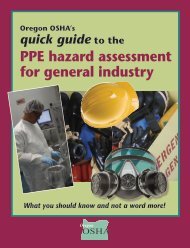Technical Manual - Section 3 (Safety Hazards)
Technical Manual - Section 3 (Safety Hazards)
Technical Manual - Section 3 (Safety Hazards)
You also want an ePaper? Increase the reach of your titles
YUMPU automatically turns print PDFs into web optimized ePapers that Google loves.
Figure III:2-14 Fluid Catalytic Cracking<br />
cracker consists of a catalyst section and a fractionating<br />
section that operate together as an integrated processing unit.<br />
The catalyst section contains the reactor and regenerator,<br />
which with the standpipe and riser forms the catalyst<br />
circulation unit. The fluid catalyst is continuously circulated<br />
between the reactor and the regenerator using air, oil vapors,<br />
and steam as the conveying media.<br />
A typical FCC process involves mixing a preheated<br />
hydrocarbon charge with hot, regenerated catalyst as it enters<br />
the riser leading to the reactor. The charge is combined with<br />
a recycle stream within the riser, vaporized, and raised to<br />
reactor temperature (900-1,000º F) by the hot catalyst. As the<br />
mixture travels up the riser, the charge is cracked at 10-30<br />
psi.<br />
In the more modern FCC units, all cracking takes place in the<br />
riser. The "reactor" no longer functions as a reactor; it merely<br />
serves as a holding vessel for the cyclones. This cracking<br />
continues until the oil vapors are separated from the catalyst<br />
in the reactor cyclones. The resultant product stream<br />
(cracked<br />
product) is then charged to a fractionating column where it is<br />
separated into fractions, and some of the heavy oil is recycled<br />
to the riser.<br />
Spent catalyst is regenerated to get rid of coke that collects on<br />
the catalyst during the process. Spent catalyst flows through<br />
the catalyst stripper to the regenerator, where most of the<br />
coke deposits burn off at the bottom where preheated air and<br />
spent catalyst are mixed. Fresh catalyst is added and worn-out<br />
catalyst removed to optimize the cracking process.<br />
MOVING BED CATALYTIC CRACKING<br />
The moving-bed catalytic cracking process is similar to the<br />
FCC process. The catalyst is in the form of pellets that are<br />
moved continuously to the top of the unit by conveyor or<br />
pneumatic lift tubes to a storage hopper, then flow downward<br />
by gravity through the reactor, and finally to a regenerator.<br />
The regenerator and hopper are isolated from the reactor by<br />
steam seals. The cracked product is separated into recycle gas,<br />
oil, clarified oil, distillate, naphtha, and wet gas.<br />
III:2-27
















